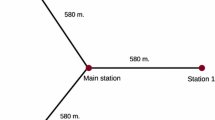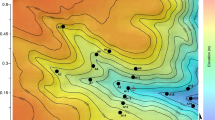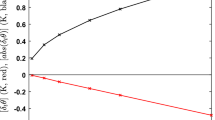Abstract
This study examines the strength and statistical behavior of mesoscale motions on time scales up to 1 h using eight data sets over different surface types. The mesoscale motions include internal gravity waves, microfront-like structures, horizontal modes, and a complex variety of other signatures, perhaps resulting from superposition of different modes. With weak large-scale flow, the mesoscale motions lead to meandering of the wind direction, as found in previous studies. However, the meandering often takes the form of sudden wind shifts rather than oscillation of wind direction.
The relative strength and impact of such mesoscale motions are examined in terms of the constancy of the wind vector, the within-record standard deviation of the wind direction and the ratio of a meso-velocity scale to the speed of the large-scale flow. The strength of the mesoscale flow varies by an order of magnitude between nights at a given site and varies systematically between sites. The statistics of the vertical structure of such motions are examined for two of the data sets, both with sonic anemometers at seven levels.
Similar content being viewed by others
References
Anfossi D, Oettl D, Degrazia G and Goulart A (2005). An analysis of sonic anemometer observations in low wind speed conditions. Bound-Layer Meteorol 114: 179–203
Arya SPS, Capauno M and Fagen L (1987). Some fluid modeling studies of flow and dispersion over two-dimensional hills. Atm Environ 21: 753–764
Chimonas G (2002). On internal gravity waves associated with the stable boundary layer. Bound-Layer Meteorol 102: 139–155
Davies B and Thomson D (1999). Comparisons of some parametrizations of wind direction variability with observations. Atm Environ 33: 4909–4917
Driedonks AGM and De Baas A (1985). Internal gravity waves in a stably stratified boundary layer. Bound-Layer Meteorol 31: 303–323
Doran JC and Horst TW (1981). Velocity and temperature oscillations in drainage winds. J Appl Meteor 20: 360–364
Edson J, Crofoot B, McGillis RW, Zappa C (2004) Investigations of flux-profile relationships in the marine atmospheric boundary layer during CBLAST. 16th Symposium on boundary layers and turbulence, 9–13 August 2004, Portland, Maine
Etling D (1990). On plume meandering under stable stratification. Atm Environ 24A: 1979–1985
Fisher NI (1987). Problems with current definitions of wind direction. J Appl Meteor 26: 1522–1529
Franzese P (2003). Lagrangian stochastic modeling of a fluctuating plume in the convective boundary layer. Atm Environ 37: 1691–1701
Fritts D, Nappo C, Riggin D, Balsley B, Eichinger W and Newsom R (2003). Analysis of ducted motions in the stable nocturnal boundary layer during CASES-99. J Atmos Sci 60: 2450–2472
Gifford FA (1959). Statistical properties of a fluctuating plume dispersion model. Adv Geophy 6: 117–137
Grisogono B and Enger L (2004). Boundary-layer variations due to orographic wave-breaking in the presence of rotation. Quart J Roy Met Soc 130: 2991–3014
Hanna SR (1983). Lateral turbulence intensity and plume meandering during stable conditions. J Clim Appl Meteorol 22: 1424–1430
Hanna SR (1986). Spectra of concentration fluctuations: the two time scales of a meandering plume. Atm Environ 20: 1131–1137
Hanna SR (1990). Lateral dispersion in Light-Wind Stable Conditions.. Nuovo Cimento 13C: 889–894
Högström U, Smedman A-S and Bergström H (1999). A case study of two-dimensional stratified turbulence. J Atmos Sci 56: 959–976
Kristensen L, Jensen NO and Peterson EL (1981). Lateral dispersion of pollutants in a very stable atmosphere; The effect of the meandering. Atm Environ 15: 837–844
Kuettner J, Hildebrand P and Clark T (1987). Convection waves: Observations of gravity wave systems over convectively active boundary layers. Quart J Roy Met Soc 113: 445–467
Kustas W, Li F, Jackson J, Preuger J, MacPherson J and Wolde M (2004). Effects of remote sensing pixel resolution on modeled energy flux variability of croplands in Iowa. Remote Sens Env 92: 535–547
LeMone MA (1973). The structure and dynamics of horizontal roll vortices in the planetary boundary layer. J Atmos Sci 30: 1077–1091
Mahrt L and Larsen S (1982). Small scale drainage front. Tellus 34: 579–587
Mahrt L and Vickers D (2005). Boundary-layer adjustment over small-scale changes of surface heat flux. Bound-Layer Meteorol 116: 313–330
Mahrt L, Lee X, Black A, Neumann H and Staebler RM (2000). Nocturnal mixing in a forest subcanopy. Agric For Meteorol 101: 67–78
Mahrt L, Moore E, Vickers D and Jensen NO (2001). Dependence of turbulent and mesoscale velocity variances on scale and stability. J Appl Meteor 40: 628–641
McWilliams J (2004). Phenomenological hunts in two-dimensional and stably stratified turbulence. In: Federovich, E, Rotunno, R and Stevens, B (eds) Atmospheric turbulence and mesoscale meteorology, pp 35–49. Cambridge University Press, Cambridge
Meunier P, Leweke T and Le Dizès S (2005). Physics of vortex merging. C R Physique 6: 431–450
Moore GE, Milich LB and Liu MK (1988). Plume behaviors observed using lidar and SF 6 tracer at a flat and hilly site. Atm Environ 22: 1673–1688
Nappo C (2002). An introduction to atmospheric gravity waves. Academic Press, New York
Nasstrom D and Gage K (1985). A climatology of atmospheric wavenumber spectra of wind and temperature observed by commercial aircraft. J Atmos Sci 42: 950–960
Oettl D, Goulert A, Degrazia AG and Anfossi D (2005). A new hypothesis on meandering atmospheric flows in low wind speed conditions. Atm Environ 39: 1739–1748
Peterson H and Lamb B (1990). Interpretation of measured tracer concentration fluctuations using a sinusoidal meandering plume model. J Appl Meteor 29: 1284–1299
Poulos G, Blumen W, Fritts D, Lundquist J, Sun J, Burns S, Nappo C, Banta R, Newsom R, Cuxart J, Terradellas E, Balsley B and Jensen M (2001). CASES-99: A comprehensive investigation of the stable nocturnal boundary layer. Bull Am Meteor Soc 83: 555–581
Riley JJ and Lelong M-P (2000). Fluid motions in the presence of strong stable stratification. Ann Rev Fluid Mech 32: 613–657
Schwarz P, Law B, Williams M, Irvine J, Kurpius M and Moore D (2004). Climatic versus biotic constraints on carbon and water fluxes in seasonally drought-affected ponderosa pine ecosystems. Global Biochem Cycles 18: 1–17
Skibin D (1984). A simple method for determining the standard deviation of wind direction. J Atmos Oc Tech 1: 101–102
Skupniewicz CE (1987). Measurements of over water diffusion: the separation of relative diffusion and meander. J Climate Appl Meteorol 26: 949–958
Smith R (2002). Stratified airflow over Mountains. In: Grimshaw, R (eds) Environmental stratified flows, pp. Kluwer Publishing, Dordrecht
Sun J, Burns SP, Lenschow DH, Banta R, Newsom R, Coulter R, Frasier S, Ince T, Nappo C, Cuxart J, Blumen W, Lee X and Hu X-Z (2002). Intermittent turbulence associated with a density current passage in the stable boundary layer. Bound-Layer Meteorol 105: 199–219
Sun J, Lenschow DH, Burns SP, Banta RM, Newsom RK, Coulter R, Frasier S, Ince T, Nappo C, Balsley B, Jensen M, Mahrt L, Miller D and Skelly B (2004). Atmospheric disturbances that generate intermittent turbulence in nocturnal boundary layers. Bound-Layer Meteorol 110: 255–279
Vickers D and Mahrt L (1997). Quality control and flux sampling problems for tower and aircraft data. J Atm Oc Tech 14: 512–526
Vickers D and Mahrt L (2006). A solution for flux contamination by mesoscale motions with very weak turbulence. Bound-Layer Meteorol 118: 431–447
Vickers D and Mahrt L (2007). Observations of the cross-wind velocity variance in the stable boundary layer. Env Fluid Mech 7: 55–71
Waite M and Bartello P (2004). Stratified turbulence dominated by vortical motion. J Fluid Mech 517: 281–308
Weil J, Snyder W, Lawson R and Shipman M (2002). Experiments on buoyant plume dispersion in a laboratory convection tank. Bound-Layer Meteorol 102: 367–414
Author information
Authors and Affiliations
Corresponding author
Rights and permissions
About this article
Cite this article
Mahrt, L. Weak-wind mesoscale meandering in the nocturnal boundary layer. Environ Fluid Mech 7, 331–347 (2007). https://doi.org/10.1007/s10652-007-9024-9
Received:
Accepted:
Published:
Issue Date:
DOI: https://doi.org/10.1007/s10652-007-9024-9




